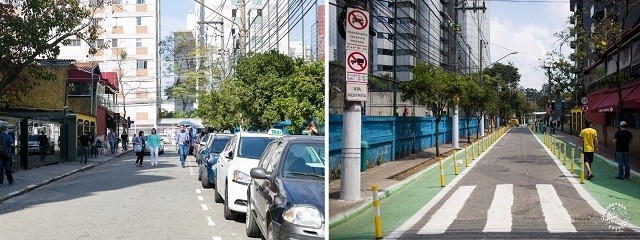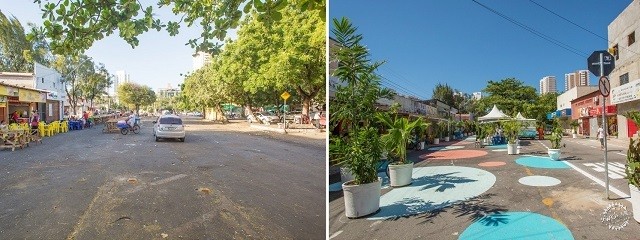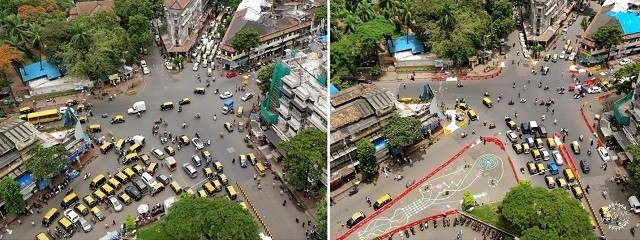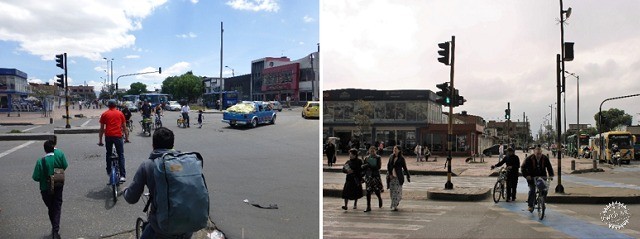
从中国到哥伦比亚:5座城市让街道更加安全
From China to Colombia, 5 Cities That Made Their Streets Safer With Urban Design
由专筑网李韧,蒋晖编译
2015年时,国际社会承诺,到了2020年,来自交通事故的伤亡数量将会减少一半。但是,每天由于交通事故所造成的死亡大约有3200人,尤其是随着街道车辆数目的增加,到了2030年,这个数字也许会翻三倍。
人们都知道,存在设计问题的街道会造成较高的伤亡率,但是,这些事件大部分都发生在低收入与中等收入国家,并且会带来诸如生产力的下降、生活品质降低等不良后果。
对于街道设计的反思是一场全球性活动,幸运的是当前社会对于城市空间的安全性问题已经有了一定的重视,而这种重视程度曾经只存在于诸如阿姆斯特丹、哥本哈根等欧洲城市,这些城市的安全街道设计已经维持了约40年。而如今世界正在进步,因此小编选择了位于巴西、中国、哥伦比亚、印度的5座城市的街道进行对比,这些城市反应了人们对于城市空间的发展进程,而每个项目都以彭博全球道路安全倡议活动为基础,从而实施了一系列创新性设计措施。
In 2015, the world community pledged to decrease half the number of deaths and grave injuries caused by traffic accidents by 2020. However, more than 3,200 deaths caused by collisions occur every day, and with the growing number of vehicles, that number can triple by 2030.
As is expected, cities with poorly designed streets have the highest rates of injuries and deaths. In fact, 90% of these collusion-related deaths happen in low to middle-income countries, and these incidents have serious consequences. Economic productivity decreases and the quality of life suffers.
Luckily, we are witnessing a global movement in the rethinking of street design. The idea of making urban spaces safer used to be limited to European cities, such as Amsterdam or Copenhagen, places where good urban design has been practiced for over 40 years. Today, improvements have been felt everywhere. We selected five cities in Brazil, China, Colombia, and India that are changing the way people navigate urban spaces. Each has implemented innovative design interventions based on the Bloomberg Initiative for Global Road Safety.

Before and after of Joel Carlos Borges Street. Image: Daniel Hunter and Pedro Mascaro/WRI Brasil
圣保罗
Joel Carlos Borges街道将Berrini火车站与城市金融中心联系在一起,每天有成千上万的人群从这里经过。在2017年9月之前,狭窄的街道已经无法满足日益增长的行人数量(在高峰时间,平均每辆车的周围都会环绕有22.5人次)。
街道中有大量的车辆,并且会对行人造成一定的风险,因此当地政府计划重新进行街道设计,其中包含有更加宽敞的行人空间、更加醒目的标识系统,同时还需降低车辆限速,增加城市小品街道景观以及绿色空间。在改造之后,人行道宽度至少为3.5米,从而更加便于行人的通行。
将狭窄的人行道拓宽、缩小机动车道、降低限速,为车辆与行人都创造了更加安全舒适的出行体验。这种改造策略不仅仅为安全的街道带来了全新蓝图,同时也提醒着司机和行人在出行时首要考虑交通安全。
这是巴西圣保罗对于城市的首次临时举措,但该举措受到了大众的肯定。这座城市同时也在考虑其他场所的类似措施。
Sao Paulo
Joel Carlos Borges Street connects the Berrini train station to the city’s financial center. Thousands of people pass through the station every day. Before September 2017, the street had narrow sidewalks that couldn’t safely accommodate the heavy flux of pedestrians (around 22.5 people per every vehicle during rush hour).
As the street is the main pathway to the station, it creates a high level of risk for pedestrians. The city decided to redesign the street to include more space for pedestrians, better signalization, reduce speed limits, add urban furniture, and green infrastructure. Now the sidewalks are over 3.5 meters wide, offering ample space for pedestrian traffic.
Widening narrow sidewalks and narrowing the traffic lanes reduces speed and creates a safe and pleasant experience for all. This new and improved design for “complete streets” not only provides a blueprint for safer streets but also reminds drivers that pedestrian safety is crucial and must be their first concern when driving.
This was the first temporary intervention in São Paulo and was well received by the public. The city is now considering similar enterprises in other places.

Before and after of Cidade 2000. Images: Rodrigo Capote/WRI Brasil
福塔莱萨
Cidade 2000在白天是居住区,而到了晚上则充满了活力,同时这里的行人数量也较多,但是街道上仍然有着大量的车辆,因此行人和骑行者都有着一定的隐藏危机。
为了改善此类现象,福塔莱萨市政府在2017年公布了“和谐交通区域”的项目,设计师将1200平方米的停车与车道改造为具有功能性的市民广场。2017年,在当地社区进行了第一次改造,项目名为“Cidade da Gente”,意思是“大众城市”,工人们将一条车道拆除,并且最高时速降低至30公里,同时将人行道、路缘拓宽,增加了人行通道,另外,改造还包括增加了街道小品、绿色空间,以及明确的标识系统。
该项目向居民展示了城市化为街道带来的生机。由于整个项目在居民中引起的反响较好,此类临时性的改造将得以永久的保存。同时,政府仍然在规划其他区域的此类低成本设计策略。
Fortaleza
Cidade 2000 is a residential neighborhood during the day and a vibrant zone at night. Despite the high number of pedestrians, the street was dominated by vehicles, leaving pedestrians and cyclists vulnerable.
To improve the safety of pedestrians and cyclists, the city of Fortaleza announced a “Calm Traffic Area” in 2017, transforming 1,200 square meters that were designated for parking and traffic lanes into a functional pedestrian square. In 2017, the neighborhood received its first temporary transformation, called “Cidade da Gente” (City for People). It included the removal of a traffic lane, a speed reduction to 30 km/h, sidewalk widening, curb extensions, and five new pedestrian crossings. The transformation also included street art, green infrastructure, and street furniture to clearly designate pedestrian space.
The project showed residents how tactile urbanism can bring life back to degraded streets. Due to the positive feedback, the temporary intervention is becoming permanent. The mayor has also announced similar low-cost interventions in other areas.

Intersection in Nagpada. Image: WRI India
孟买
诸如孟买城市的其他交叉路口,Nagpada路口同样混乱,这对行人、骑行者、司机来说都极具挑战。
这个三角路口连接着6条主要交通干道,周边都是一些重要的学区。然而,这个路口每个小时的车流量是3000辆,交通时常瘫痪,行人所有的空间几乎没有,人行道上应有得设施也减少了许多,从而这个路口的通行效率较低,同时也存在着许多潜在的风险。数据表明,Nagpada在孟买的交通故事伤亡中拥有很高的指数。
在2017年8月,这个三角形路口经过改造交通得以疏导,行人也有了全新的道路。规划者们减少了交叉口之间的距离,重新规划交通流线,同时还设置了广场,使得曾经混乱的地方现在变为了人们的聚集场所,这样的规划也让城市的交警松了一口气。
Nagpada的成功改造促进了城市的永久性改革。
Mumbai
The Nagpada intersection is chaotic and challenging for all its users, motorized or not, as are many others intersections in Mumbai.
The triangular junction connects six main roads and serves many school districts. However, it hosts 3,000 vehicles during rush hour, resulting in heavy traffic. Pedestrians had little to no space, and what existed for sidewalks was degraded. These factors created an inefficient, dangerous, and confusing intersection. Accident data showed that Nagpada was responsible for a third of all traffic deaths in Mumbai.
In August of 2017, the triangular geometry was temporarily changed to channel the traffic and allow for safer new paths for pedestrians. The crossing distances were reduced and new crossings were made on all sides. The project has also redesignated ground from illegal parking into a square. The chaotic intersection has become a place for new encounters. The new arrangement has also made managing the intersection easier for the traffic police of Mumbai.
Nagpada’s success convinced the city to commit to a permanent change.

Intersection at Carrera 80 with Calle 43 Sur. Images by Carsten Wass, José Segundo López/WRI
波哥大
波哥大的Kennedy区有着大量的人车流量,因为对于许多居住在城市郊区的市民来说,骑行是他们的主要交通方式。
在2013年至2017年间,单Carrera 80和Calle 43 Sur两个交叉口所发生的交通事故就高达61起,其中造成了1人死亡。由于信号体系的缺乏,这里的行人和骑行者常常处于危险之中,而不良的道路规划也使得行人与车辆流线形成冲突,这为行人带来了巨大的安全隐患。
为了确保人们的出行安全,城市在2018年1月对交叉口进行了重新规划,规划者减少了车道数量、增加了非机动车道、行人区域,还有一些显眼的坡道入口和标识系统。这让非机动车的骑行者和行人都更加安全。
Bogota
Bogotá's Kennedy district is well known for its heavy pedestrian and cycling traffic. For many residents who live on the outskirts of the city, cycling is usually the most convenient transportation method to go to and from work, school, and home.
Between 2013 and 2017, 61 traffic accidents and one death were registered at the intersection of Carrera 80 and Calle 43 Sur. Pedestrians and cyclists were in danger due to the lack of signalization, access ramps, and traffic lights to ensure safe crossings. The poor design also directed cyclists to ride opposite of oncoming traffic which resulted in conflicts with pedestrians.
To ensure safer conditions for all, the city redesigned the intersection in January of 2018. The renovation included reducing lanes, adding cycling lanes, pedestrian crossings, better access ramp, and pedestrian traffic lights. It resulted in a safer route for cyclists and an improved safety for pedestrians.

Zhengtong Street. Image: WRI China
上海
杨浦区政通路连接着上海复旦大学与一所中学,街道宽度为15至20米,因此这里有着大量的交通流量。
但是,政通路上并没有设置非机动车道,这让骑行者极为不便,同时这对于学生的通行来说也非常危险。
为了行人的安全,杨浦区政府进行了道路的重新规划,将自行车道和人行道分隔开,同时减少车道,并增加标识系统。
这样的改造深受当地人们的肯定,政通路是上海道路改造的一大成功案例。
城市的街道是公共空间设计中极为重要的组成部分,但是却常常被人们所忽略,这不仅仅是高收入经济社会的代名词,更是人人都应该注意的空间场所。
关于作者:
Nikita Luke是可持续城市WRI Ross中心的健康与道路安全研究助理。
Ben Welle是可持续城市WRI Ross中心的健康与道路全球经理人。
新闻来源:TheCityFix Brasil
Shanghai
Zhengtong Street connects the commercial district of Yangpu to a high school and the Fudan University campus in Shanghai. The 15-20 meter wide street serves a heavy influx of pedestrians with a mid-range amount of traffic.
Zhengtong didn't have a pedestrian or cycling infrastructure, hindering the uses of both. Another concern was the crosswalk in front of the school that endangered pedestrians.
To promote a safer environment, the Yangpu District implemented separated bike lanes and improved sidewalks. They also narrowed the road (which facilitated crossings), added reflective materials to solar panelled stop signs, and street signalization.
The transformation was well received by district workers, local cyclists, and students. Zhentong Street now serves as an example of road safety for other Shanghai districts.
While urban streets are fundamental public spaces, they are also one of the most neglected. What was before a privilege for high-income economies, is now becoming a necessity for countries throughout the world.
About the authors:
Nikita Luke is a Research Assistant for Health and Road Safety at WRI Ross Center for Sustainable Cities.
Ben Welle is a Global Manager for Health and Road Safety at WRI Ross Center for Sustainable Cities.
Via TheCityFix Brasil.
|
|
